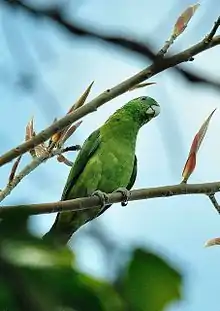Blue-headed racket-tail
The blue-headed racket-tail (Prioniturus platenae), also known as the Palawan racket-tail and locally as kinawihan,[2] is a parrot found in the western Philippines around Palawan. It inhabits humid lowland forest in small flocks. It is threatened by habitat destruction and limited trapping for the cage-bird trade.
| Blue-headed racket-tail | |
|---|---|
 | |
| Scientific classification | |
| Kingdom: | Animalia |
| Phylum: | Chordata |
| Class: | Aves |
| Order: | Psittaciformes |
| Family: | Psittaculidae |
| Genus: | Prioniturus |
| Species: | P. platenae |
| Binomial name | |
| Prioniturus platenae Blasius, 1888 | |
Taxonomy
The species was formerly considered conspecific with the blue-crowned racket-tail.[3]
Description
The blue-headed racket-tail is 27–28 cm long. The plumage is green with a bright, light blue head, blue underwings (except for green coverts) and, in the male, a bluish breast. The beak is bluish gray and iris is yellowish.[4] The species utters a variety of raucous squawks with the occasional musical phrase.[1]
Distribution and habitat
The species is endemic to the islands of Palawan, Balabac Island, Dumaran Island, Linapacan, Culion, and Busuanga Island. Estimated population size is approximately 2,500-10,000 birds.[5] This corresponds to about 1,500-7,000 mature individuals.[1]
It inhabits lowland forest and adjacent cultivated areas, and occasionally scrubland and mangroves, at altitudes of up to at least 300 m.[1]
Ecology
Little is known about this parrot. It is seen in pairs or small flocks, and tends to be very noisy in flight but more silent while feeding. The species feeds on a wide variety of nuts and fruits.[4] It feeds regularly in banana plantation, resulting in some persecution as a pest.[5]
Clutch size is unknown. Eggs are about 31.5 x 26 mm in size.
Threats and Conservation
The species is currently classified as Vulnerable by the IUCN, and has been since 1994. While there are no reliable current trend estimates, the presence of a variety of environmental threats make an ongoing population decline very likely.[1]
Deforestation is considered the worst threat. On Palawan, deforestation has been rapid due to large mining and logging operations. Mining for chromite on Palawan (and surrounding islands) has contributed majorly to habitat destruction in the area. Illegal logging seems to prevalent in southern Palawan, further putting the blue-headed racket-tail at risk. Capture for the illegal exotic pet trade has a minor impact, as it is usually only captured and sold locally, with very few shipments going out of the Palawan area. Most of the time, the birds die quickly in captivity.[5]
The species is present in conservation areas, since the entirety of Palawan is technically a game reserve where hunting is illegal (however this still occurs), and there are populations in several other protected areas.[1]
References
- BirdLife International (2012). "Prioniturus platenae". IUCN Red List of Threatened Species. 2012. Retrieved 26 November 2013.CS1 maint: ref=harv (link)
- "2003 Statistics on Philippine Protected Areas and Wildlife Resources". Department of Environment and Natural Resources. 2003. Archived from the original on 2017-03-12. Retrieved 2020-07-03.
- del Hoyo, J.; Elliott, A.; Sargatal, J. (1997). Handbook of the Birds of the World. 4: Sandgrouse to Cuckoos. Barcelona, Spain: Lynx Edicions.
- "Blue-headed Racquet-tailed Parrot (Prioniturus platenae)". World Parrot Trust. Retrieved 2016-12-20.
- "Blue-headed Racquet-tail (Prioniturus platenae) - BirdLife species factsheet". BirdLife International. Retrieved 2016-12-20.
Further reading
| Wikimedia Commons has media related to Prioniturus platenae. |
- Juniper & Parr (1998) Parrots: A Guide to Parrots of the World; ISBN 0-300-07453-0.
External links
- Oriental Bird Images: Blue-headed Racquet-tail Selected photos
